2004 CHEVROLET ASTRO CARGO VAN wheel torque
[x] Cancel search: wheel torquePage 100 of 386
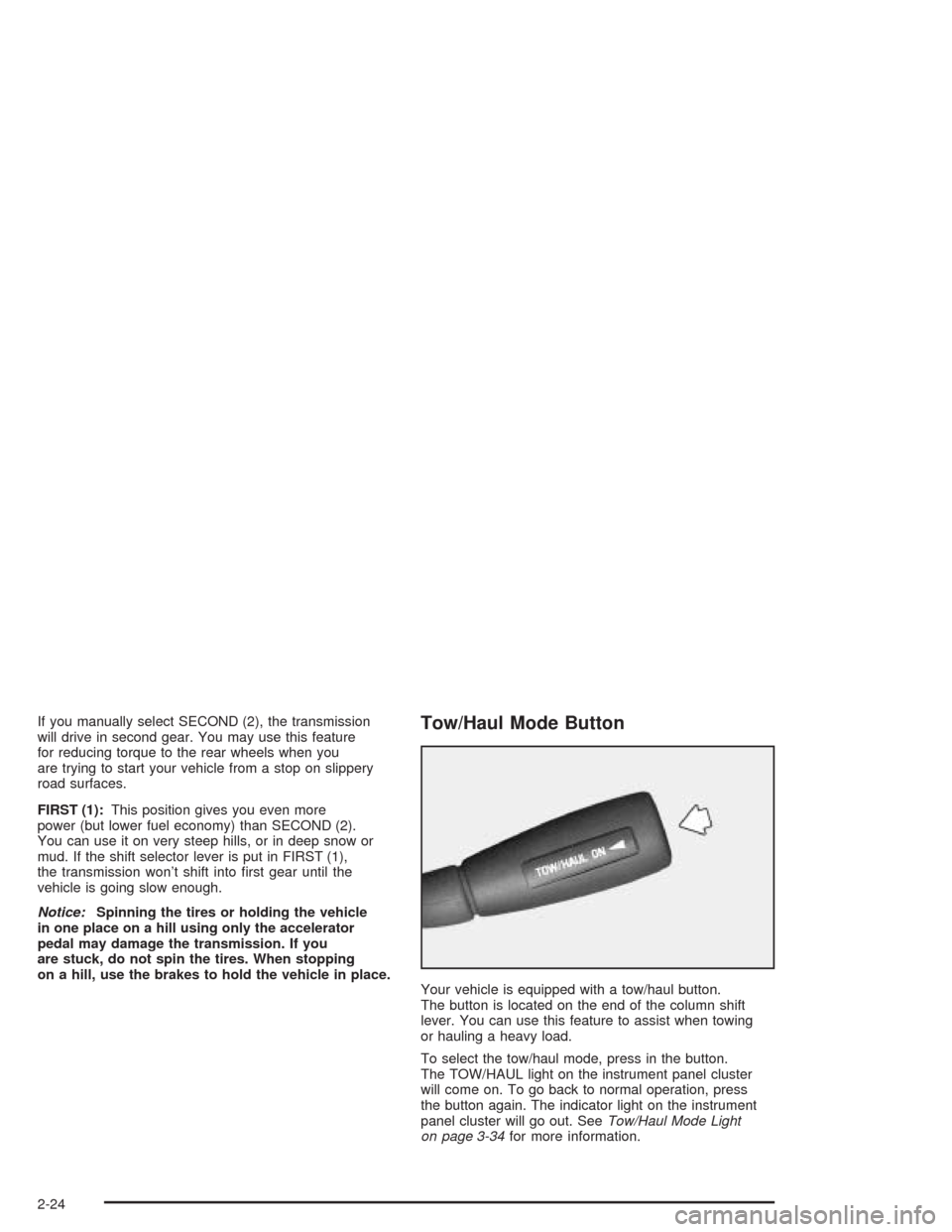
If you manually select SECOND (2), the transmission
will drive in second gear. You may use this feature
for reducing torque to the rear wheels when you
are trying to start your vehicle from a stop on slippery
road surfaces.
FIRST (1):This position gives you even more
power (but lower fuel economy) than SECOND (2).
You can use it on very steep hills, or in deep snow or
mud. If the shift selector lever is put in FIRST (1),
the transmission won’t shift into �rst gear until the
vehicle is going slow enough.
Notice:Spinning the tires or holding the vehicle
in one place on a hill using only the accelerator
pedal may damage the transmission. If you
are stuck, do not spin the tires. When stopping
on a hill, use the brakes to hold the vehicle in place.Tow/Haul Mode Button
Your vehicle is equipped with a tow/haul button.
The button is located on the end of the column shift
lever. You can use this feature to assist when towing
or hauling a heavy load.
To select the tow/haul mode, press in the button.
The TOW/HAUL light on the instrument panel cluster
will come on. To go back to normal operation, press
the button again. The indicator light on the instrument
panel cluster will go out. SeeTow/Haul Mode Light
on page 3-34for more information.
2-24
Page 257 of 386
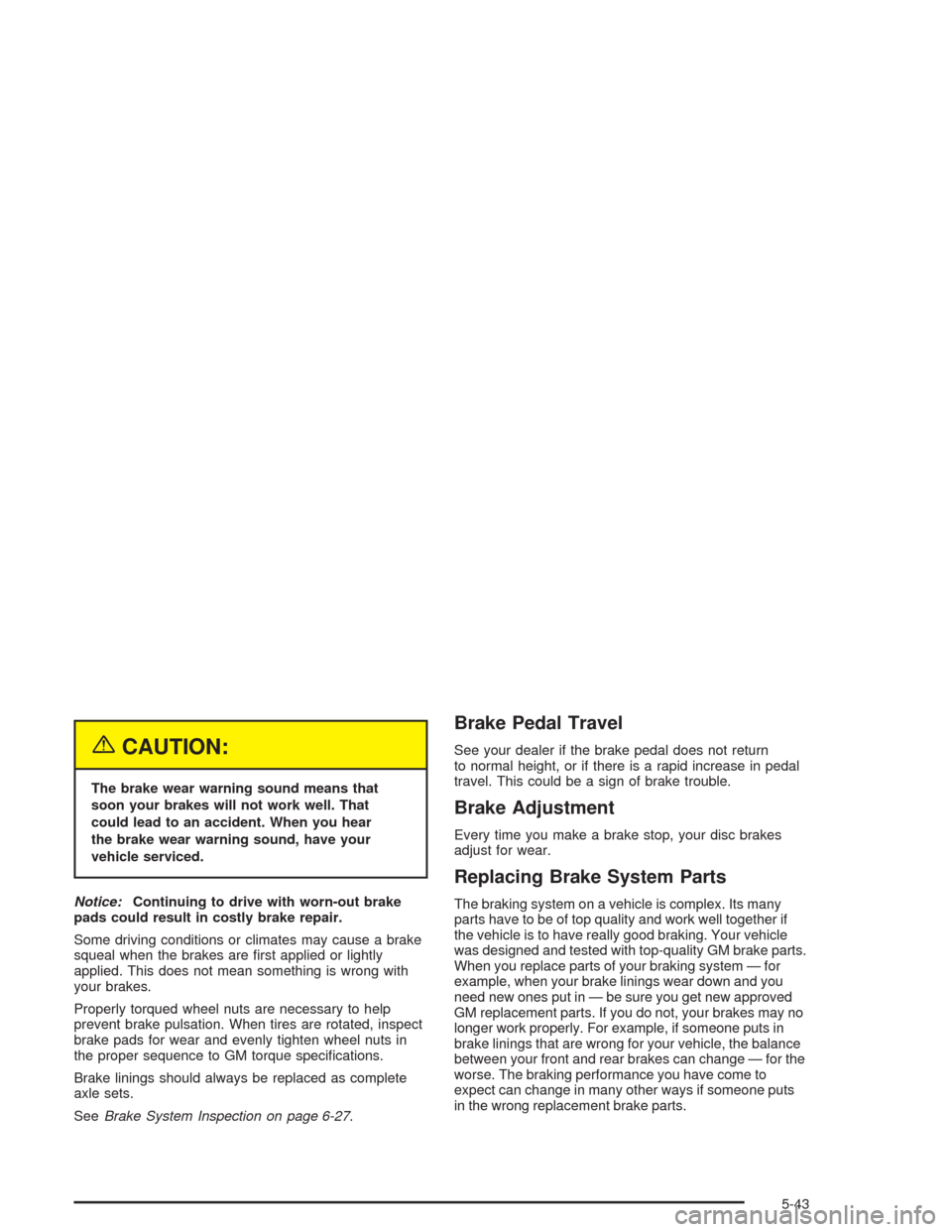
{CAUTION:
The brake wear warning sound means that
soon your brakes will not work well. That
could lead to an accident. When you hear
the brake wear warning sound, have your
vehicle serviced.
Notice:Continuing to drive with worn-out brake
pads could result in costly brake repair.
Some driving conditions or climates may cause a brake
squeal when the brakes are �rst applied or lightly
applied. This does not mean something is wrong with
your brakes.
Properly torqued wheel nuts are necessary to help
prevent brake pulsation. When tires are rotated, inspect
brake pads for wear and evenly tighten wheel nuts in
the proper sequence to GM torque speci�cations.
Brake linings should always be replaced as complete
axle sets.
SeeBrake System Inspection on page 6-27.
Brake Pedal Travel
See your dealer if the brake pedal does not return
to normal height, or if there is a rapid increase in pedal
travel. This could be a sign of brake trouble.
Brake Adjustment
Every time you make a brake stop, your disc brakes
adjust for wear.
Replacing Brake System Parts
The braking system on a vehicle is complex. Its many
parts have to be of top quality and work well together if
the vehicle is to have really good braking. Your vehicle
was designed and tested with top-quality GM brake parts.
When you replace parts of your braking system — for
example, when your brake linings wear down and you
need new ones put in — be sure you get new approved
GM replacement parts. If you do not, your brakes may no
longer work properly. For example, if someone puts in
brake linings that are wrong for your vehicle, the balance
between your front and rear brakes can change — for the
worse. The braking performance you have come to
expect can change in many other ways if someone puts
in the wrong replacement brake parts.
5-43
Page 286 of 386
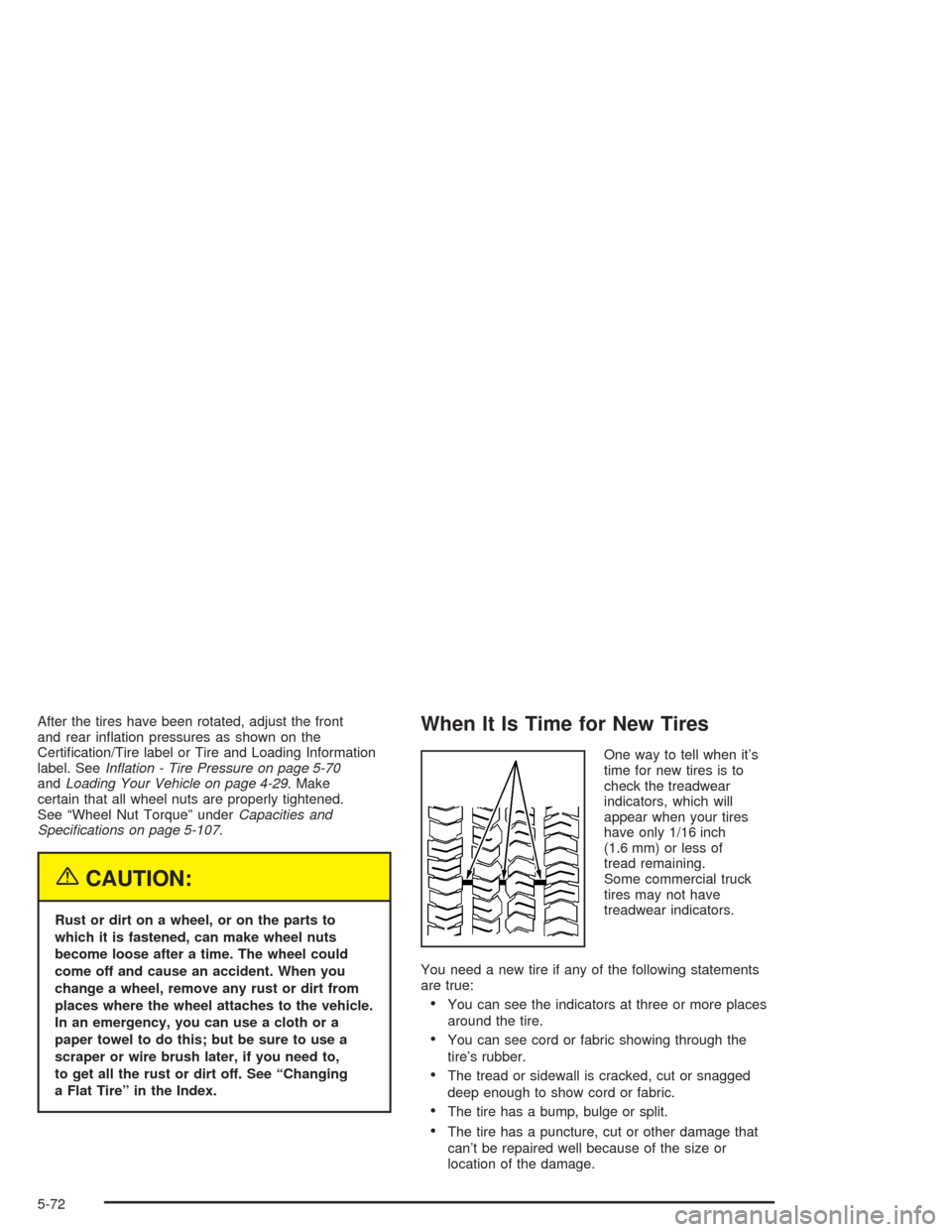
After the tires have been rotated, adjust the front
and rear in�ation pressures as shown on the
Certi�cation/Tire label or Tire and Loading Information
label. SeeIn�ation - Tire Pressure on page 5-70
andLoading Your Vehicle on page 4-29. Make
certain that all wheel nuts are properly tightened.
See “Wheel Nut Torque” underCapacities and
Speci�cations on page 5-107.
{CAUTION:
Rust or dirt on a wheel, or on the parts to
which it is fastened, can make wheel nuts
become loose after a time. The wheel could
come off and cause an accident. When you
change a wheel, remove any rust or dirt from
places where the wheel attaches to the vehicle.
In an emergency, you can use a cloth or a
paper towel to do this; but be sure to use a
scraper or wire brush later, if you need to,
to get all the rust or dirt off. See “Changing
a Flat Tire” in the Index.
When It Is Time for New Tires
One way to tell when it’s
time for new tires is to
check the treadwear
indicators, which will
appear when your tires
have only 1/16 inch
(1.6 mm) or less of
tread remaining.
Some commercial truck
tires may not have
treadwear indicators.
You need a new tire if any of the following statements
are true:
You can see the indicators at three or more places
around the tire.
You can see cord or fabric showing through the
tire’s rubber.
The tread or sidewall is cracked, cut or snagged
deep enough to show cord or fabric.
The tire has a bump, bulge or split.
The tire has a puncture, cut or other damage that
can’t be repaired well because of the size or
location of the damage.
5-72
Page 302 of 386
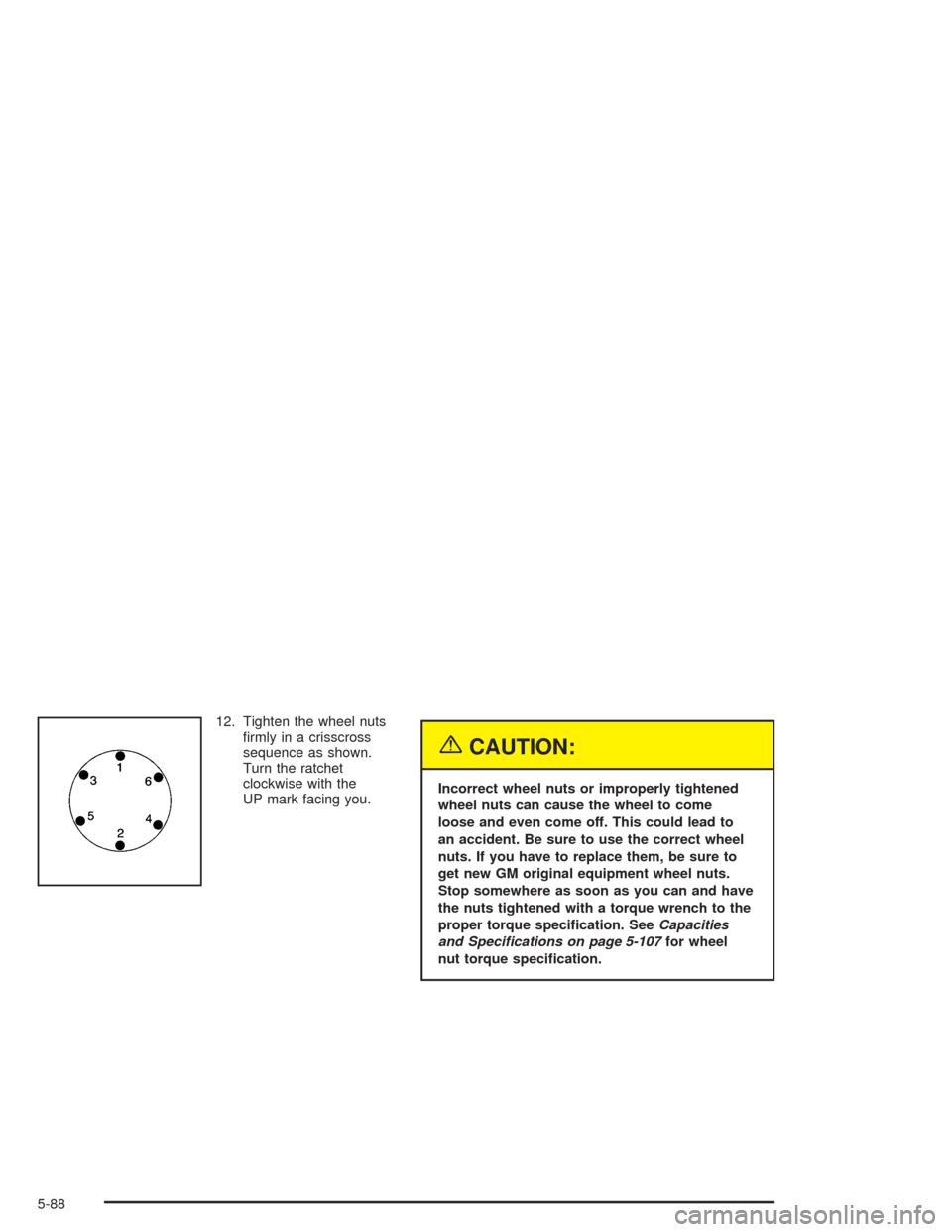
12. Tighten the wheel nuts
�rmly in a crisscross
sequence as shown.
Turn the ratchet
clockwise with the
UP mark facing you.
{CAUTION:
Incorrect wheel nuts or improperly tightened
wheel nuts can cause the wheel to come
loose and even come off. This could lead to
an accident. Be sure to use the correct wheel
nuts. If you have to replace them, be sure to
get new GM original equipment wheel nuts.
Stop somewhere as soon as you can and have
the nuts tightened with a torque wrench to the
proper torque speci�cation. SeeCapacities
and Specifications on page 5-107for wheel
nut torque speci�cation.
5-88
Page 303 of 386
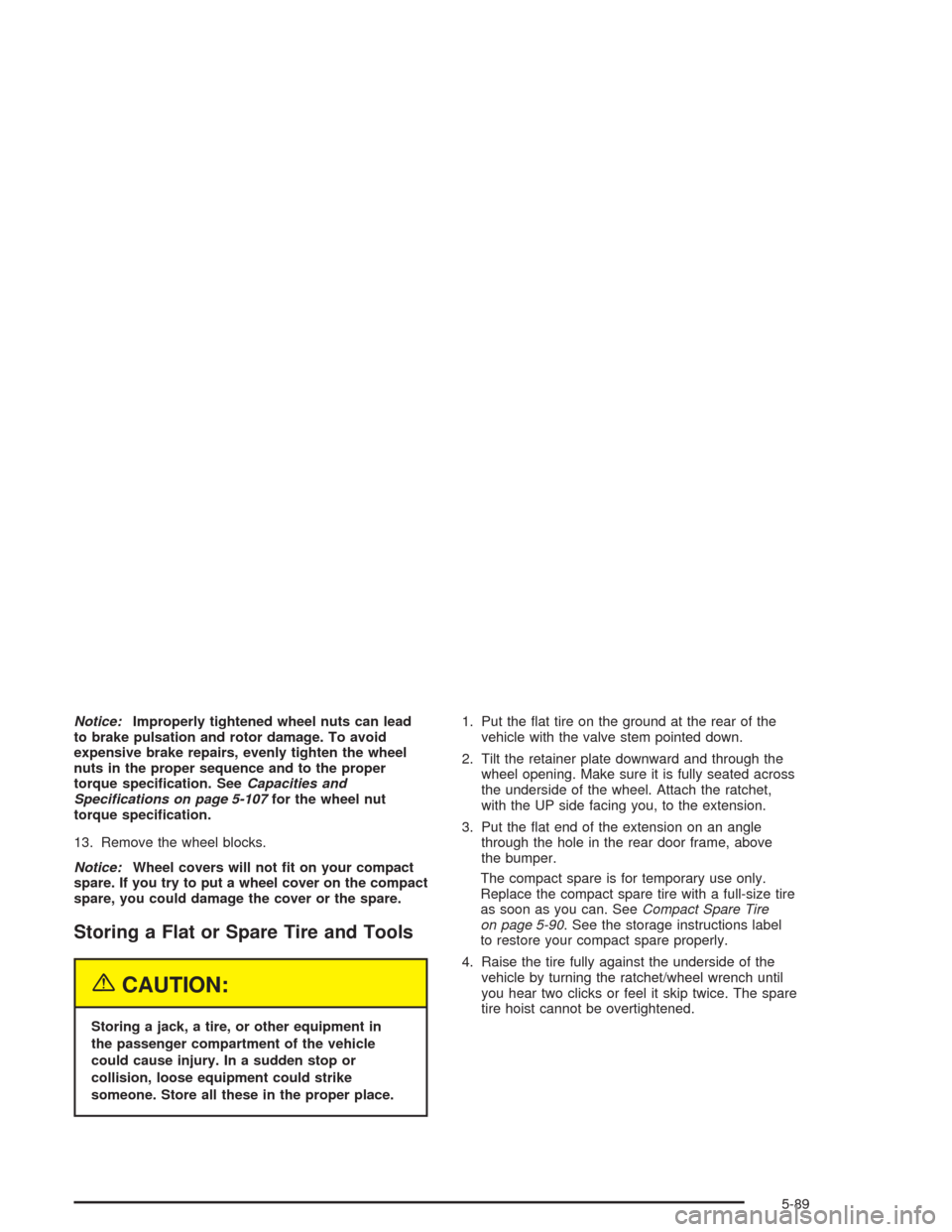
Notice:Improperly tightened wheel nuts can lead
to brake pulsation and rotor damage. To avoid
expensive brake repairs, evenly tighten the wheel
nuts in the proper sequence and to the proper
torque speci�cation. SeeCapacities and
Specifications on page 5-107for the wheel nut
torque speci�cation.
13. Remove the wheel blocks.
Notice:Wheel covers will not �t on your compact
spare. If you try to put a wheel cover on the compact
spare, you could damage the cover or the spare.
Storing a Flat or Spare Tire and Tools
{CAUTION:
Storing a jack, a tire, or other equipment in
the passenger compartment of the vehicle
could cause injury. In a sudden stop or
collision, loose equipment could strike
someone. Store all these in the proper place.1. Put the �at tire on the ground at the rear of the
vehicle with the valve stem pointed down.
2. Tilt the retainer plate downward and through the
wheel opening. Make sure it is fully seated across
the underside of the wheel. Attach the ratchet,
with the UP side facing you, to the extension.
3. Put the �at end of the extension on an angle
through the hole in the rear door frame, above
the bumper.
The compact spare is for temporary use only.
Replace the compact spare tire with a full-size tire
as soon as you can. SeeCompact Spare Tire
on page 5-90. See the storage instructions label
to restore your compact spare properly.
4. Raise the tire fully against the underside of the
vehicle by turning the ratchet/wheel wrench until
you hear two clicks or feel it skip twice. The spare
tire hoist cannot be overtightened.
5-89
Page 322 of 386
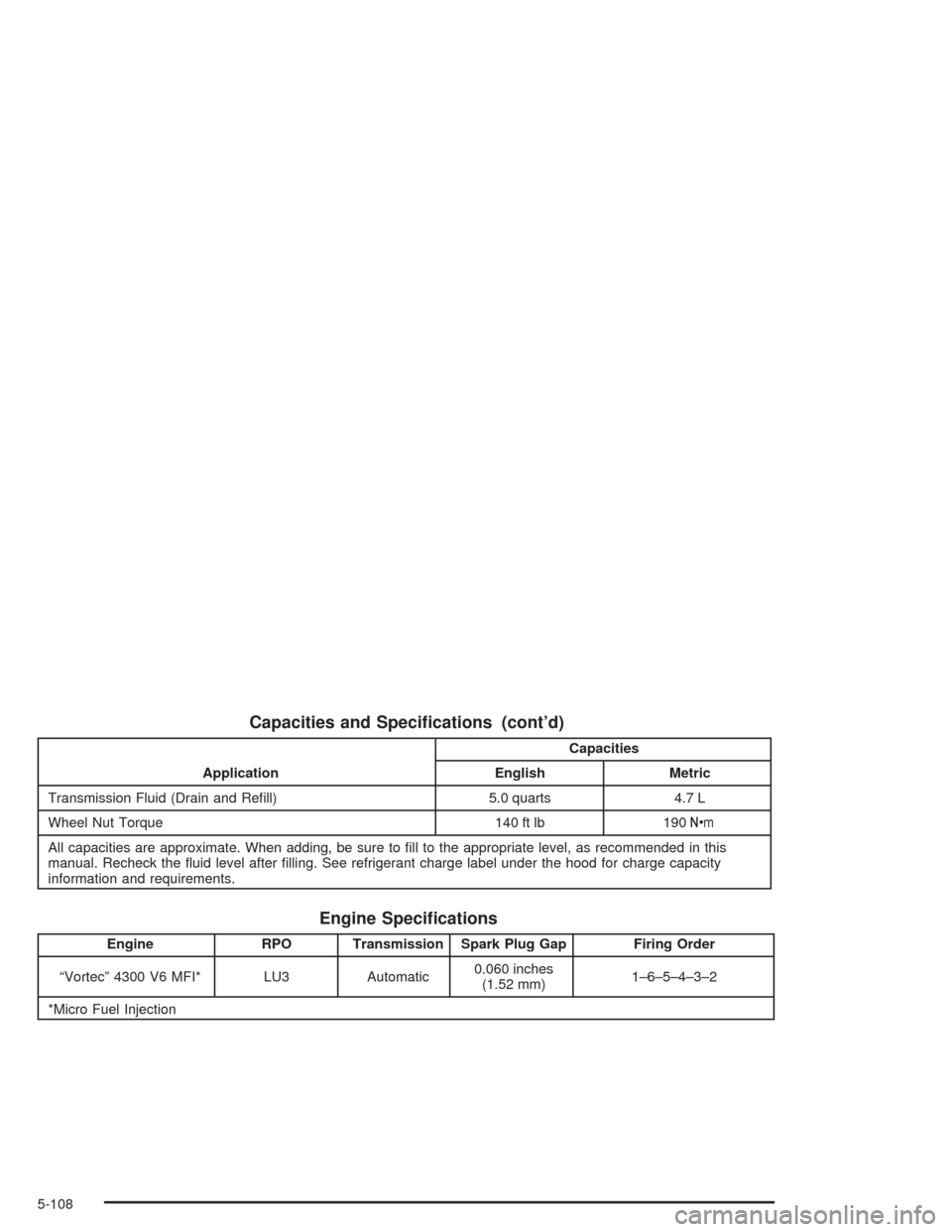
Capacities and Speci�cations (cont’d)
ApplicationCapacities
English Metric
Transmission Fluid (Drain and Re�ll) 5.0 quarts 4.7 L
Wheel Nut Torque 140 ft lb 190Y
All capacities are approximate. When adding, be sure to �ll to the appropriate level, as recommended in this
manual. Recheck the �uid level after �lling. See refrigerant charge label under the hood for charge capacity
information and requirements.
Engine Speci�cations
Engine RPO Transmission Spark Plug Gap Firing Order
“Vortec” 4300 V6 MFI* LU3 Automatic0.060 inches
(1.52 mm)1–6–5–4–3–2
*Micro Fuel Injection
5-108
Page 384 of 386
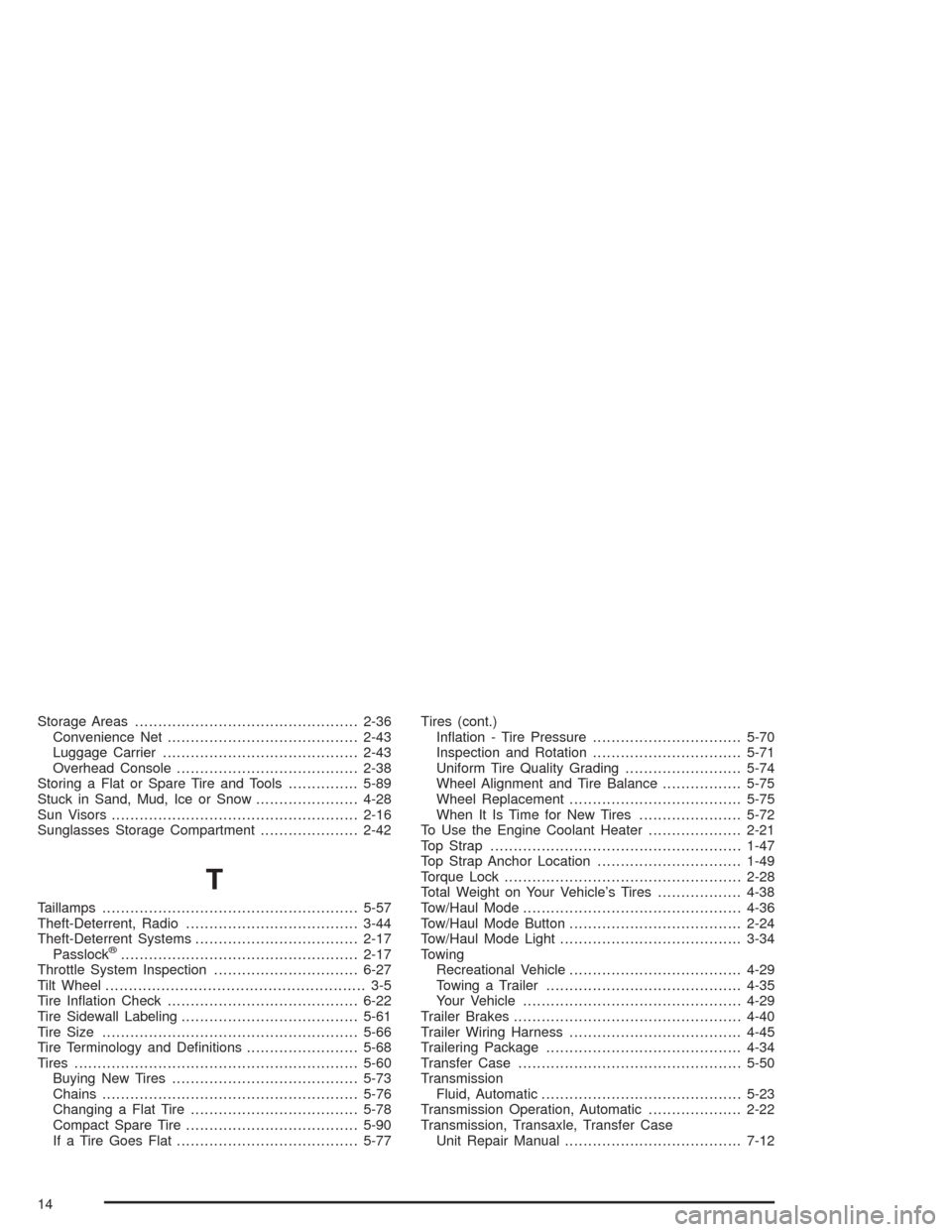
Storage Areas................................................2-36
Convenience Net.........................................2-43
Luggage Carrier..........................................2-43
Overhead Console.......................................2-38
Storing a Flat or Spare Tire and Tools...............5-89
Stuck in Sand, Mud, Ice or Snow......................4-28
Sun Visors.....................................................2-16
Sunglasses Storage Compartment.....................2-42
T
Taillamps.......................................................5-57
Theft-Deterrent, Radio.....................................3-44
Theft-Deterrent Systems...................................2-17
Passlock
®...................................................2-17
Throttle System Inspection...............................6-27
Tilt Wheel........................................................ 3-5
Tire In�ation Check.........................................6-22
Tire Sidewall Labeling......................................5-61
Tire Size.......................................................5-66
Tire Terminology and De�nitions........................5-68
Tires.............................................................5-60
Buying New Tires........................................5-73
Chains.......................................................5-76
Changing a Flat Tire....................................5-78
Compact Spare Tire.....................................5-90
If a Tire Goes Flat.......................................5-77Tires (cont.)
In�ation - Tire Pressure................................5-70
Inspection and Rotation................................5-71
Uniform Tire Quality Grading.........................5-74
Wheel Alignment and Tire Balance.................5-75
Wheel Replacement.....................................5-75
When It Is Time for New Tires......................5-72
To Use the Engine Coolant Heater....................2-21
Top Strap......................................................1-47
Top Strap Anchor Location...............................1-49
Torque Lock...................................................2-28
Total Weight on Your Vehicle’s Tires..................4-38
Tow/Haul Mode...............................................4-36
Tow/Haul Mode Button.....................................2-24
Tow/Haul Mode Light.......................................3-34
Towing
Recreational Vehicle.....................................4-29
Towing a Trailer..........................................4-35
Your Vehicle...............................................4-29
Trailer Brakes.................................................4-40
Trailer Wiring Harness.....................................4-45
Trailering Package..........................................4-34
Transfer Case................................................5-50
Transmission
Fluid, Automatic...........................................5-23
Transmission Operation, Automatic....................2-22
Transmission, Transaxle, Transfer Case
Unit Repair Manual......................................7-12
14